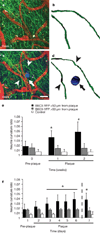Rapid appearance and local toxicity of amyloid-beta plaques in a mouse model of Alzheimer's disease
- PMID: 18256671
- PMCID: PMC3264491
- DOI: 10.1038/nature06616
Rapid appearance and local toxicity of amyloid-beta plaques in a mouse model of Alzheimer's disease
Abstract
Senile plaques accumulate over the course of decades in the brains of patients with Alzheimer's disease. A fundamental tenet of the amyloid hypothesis of Alzheimer's disease is that the deposition of amyloid-beta precedes and induces the neuronal abnormalities that underlie dementia. This idea has been challenged, however, by the suggestion that alterations in axonal trafficking and morphological abnormalities precede and lead to senile plaques. The role of microglia in accelerating or retarding these processes has been uncertain. To investigate the temporal relation between plaque formation and the changes in local neuritic architecture, we used longitudinal in vivo multiphoton microscopy to sequentially image young APPswe/PS1d9xYFP (B6C3-YFP) transgenic mice. Here we show that plaques form extraordinarily quickly, over 24 h. Within 1-2 days of a new plaque's appearance, microglia are activated and recruited to the site. Progressive neuritic changes ensue, leading to increasingly dysmorphic neurites over the next days to weeks. These data establish plaques as a critical mediator of neuritic pathology.
Figures



Comment in
-
Neuropathology: Alzheimer's in real time.Nature. 2008 Feb 7;451(7179):638-9. doi: 10.1038/451638a. Nature. 2008. PMID: 18256653 No abstract available.
References
-
- Hardy J, Selkoe DJ. The amyloid hypothesis of Alzheimer’s disease: progress and problems on the road to therapeutics. Science. 2002;297:353–356. - PubMed
-
- Stokin GB, et al. Axonopathy and transport deficits early in the pathogenesis of Alzheimer’s disease. Science. 2005;307:1282–1288. - PubMed
-
- Jankowsky JL, et al. Co-expression of multiple transgenes in mouse CNS: a comparison of strategies. Biomol. Eng. 2001;17:157–165. - PubMed
-
- Jankowsky JL, et al. Mutant presenilins specifically elevate the levels of the 42 residue beta-amyloid peptide in vivo: evidence for augmentation of a 42-specific gamma secretase. Hum. Mol. Genet. 2004;13:159–170. - PubMed
Publication types
MeSH terms
Substances
Grants and funding
LinkOut - more resources
Full Text Sources
Other Literature Sources
Medical
Molecular Biology Databases

